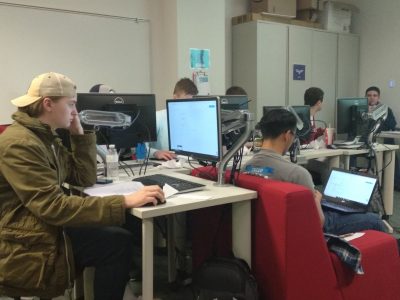 On Friday, March 29th, OPIM Innovate hosted its Alexa Skill-Building Workshop from 1:00 PM to 3:00 PM in the Gladstein Lab, BUSN 309. Led by Tyler Lauretti (MIS ’18), a Travelers Information Technology Leadership Development Program employee and Alexa developer, the workshop introduced Amazon’s Alexa service through the lens of artificial intelligence and offered attendees the opportunity to develop their own Alexa skills, or voice-activated applications, with a zero-code graphical interface called Voiceflow.
On Friday, March 29th, OPIM Innovate hosted its Alexa Skill-Building Workshop from 1:00 PM to 3:00 PM in the Gladstein Lab, BUSN 309. Led by Tyler Lauretti (MIS ’18), a Travelers Information Technology Leadership Development Program employee and Alexa developer, the workshop introduced Amazon’s Alexa service through the lens of artificial intelligence and offered attendees the opportunity to develop their own Alexa skills, or voice-activated applications, with a zero-code graphical interface called Voiceflow.
Before introducing attendees to Alexa skill building, Lauretti wanted to describe the Alexa with artificial intelligence (A.I.) terminology. “The speech recognition and natural language processing realms [of A.I.] really make up the core of Alexa,” said Lauretti, “but what really makes Alexa and other voice assistants strong and powerful is machine learning.” Alexa, through speech and natural language processing, is able to extract pertinent information from voice requests and transform recordings into text. From these voice requests, she is also able to extract information to formulate a text response, and then voice that response to the user. With machine learning added to the mix, Alexa is able to learn with each request, and her underlying models get better over time. This is why, for example, an Alexa user with a strong accent is more easily understood the more they use the device.
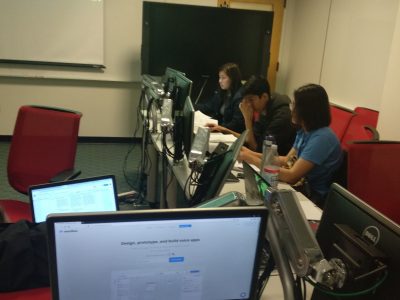 In addition to the A.I. exposition of the workshop, Lauretti also clarified a few common, yet incorrect assumptions about the Amazon Alexa. For one, the Alexa cannot be purchased from Amazon, unlike their Echo and Dot smart speakers. Why? Unlike Amazon’s physical hardware, the Alexa is a cloud-based voice service that connects to all Amazon smart devices and some third-party devices. As such, while Alexa is a complement to Amazon’s smart speakers, she is also the overarching artificial intelligence framework that keeps every device responsive. When Alexa is asked something through a smart speaker, for example, a recording of the request is sent to the Amazon cloud for processing and analysis. Then, once the meaning of the message is predicted, Alexa gives you her best response.
In addition to the A.I. exposition of the workshop, Lauretti also clarified a few common, yet incorrect assumptions about the Amazon Alexa. For one, the Alexa cannot be purchased from Amazon, unlike their Echo and Dot smart speakers. Why? Unlike Amazon’s physical hardware, the Alexa is a cloud-based voice service that connects to all Amazon smart devices and some third-party devices. As such, while Alexa is a complement to Amazon’s smart speakers, she is also the overarching artificial intelligence framework that keeps every device responsive. When Alexa is asked something through a smart speaker, for example, a recording of the request is sent to the Amazon cloud for processing and analysis. Then, once the meaning of the message is predicted, Alexa gives you her best response.
As Alexa is a speech and natural language processor, developing apps for her is restricted to her ability to “hear” and to “speak.” As such, for Alexa skills, they have to be built so that they are “voice first,” or able to be used with just vocal input. This can be a weakness in some cases, especially for developers who want to create Alexa skills that may require the user to divulge sensitive information out loud. In Lauretti’s experience, the best way to develop an Alexa skill is to have it be “something that’s fun for you to do.” This can range from Disney trivia to teaching Alexa how to help users figure out whether or not they should order pizza or wings for the night, skills Lauretti has created in the past. Skill building can also be practical for businesses, and many businesses are currently building their own Alexa skills to make the customer experience better. Yet, like with speaking with a friend, Alexa responses should always include natural contractions and pauses, utilize follow-up questions, and have variation like “Sure!” and “Got it!”.
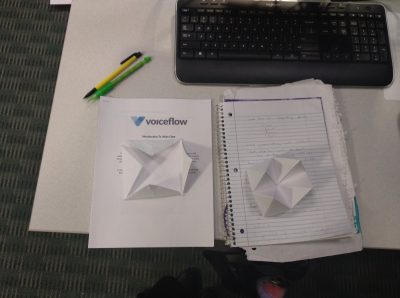 Before utilizing Voiceflow, Lauretti had attendees create paper fortune tellers (shown to the right). The point of the exercise was to show how Alexa can only process voice information, and cannot utilize any other “senses” in order to make a decision. As such, while paper fortune tellers require you to pull, fold, unfold, and process visual information, Alexa cannot do that with her limitations; she can only be programmed to listen and respond. Thus, when attendees began to use Voiceflow, which allows you to chain commands and responses together in a circular decision-tree-like diagram, all of the different blocks available for use on the graphical interface involved either speaking or listening for information. For example, in emulating a paper fortune teller game, a “Speak” block can be created with directions on which color to pick so Alexa can voice them to the user. Then, that “Speak” block can be chained to a “Choice” block outlining all of the different choices to search for in the voice input (blue, red, yellow, or green, for example). If the user does not pick a color on that list, the “Choice” block can be linked back to the “Speak” block through an “else” option so Alexa can clarify the different color choices, again. As can be inferred, an Alexa skill diagram utilizing Voiceflow can become very involved very quickly. However, even if the visual model can become fairly complex, it is very simple to build.
Before utilizing Voiceflow, Lauretti had attendees create paper fortune tellers (shown to the right). The point of the exercise was to show how Alexa can only process voice information, and cannot utilize any other “senses” in order to make a decision. As such, while paper fortune tellers require you to pull, fold, unfold, and process visual information, Alexa cannot do that with her limitations; she can only be programmed to listen and respond. Thus, when attendees began to use Voiceflow, which allows you to chain commands and responses together in a circular decision-tree-like diagram, all of the different blocks available for use on the graphical interface involved either speaking or listening for information. For example, in emulating a paper fortune teller game, a “Speak” block can be created with directions on which color to pick so Alexa can voice them to the user. Then, that “Speak” block can be chained to a “Choice” block outlining all of the different choices to search for in the voice input (blue, red, yellow, or green, for example). If the user does not pick a color on that list, the “Choice” block can be linked back to the “Speak” block through an “else” option so Alexa can clarify the different color choices, again. As can be inferred, an Alexa skill diagram utilizing Voiceflow can become very involved very quickly. However, even if the visual model can become fairly complex, it is very simple to build.
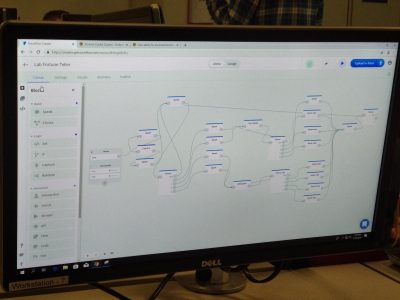 After the Alexa Skill-Building Workshop, many students left with a greater understanding of the Alexa service and Alexa skills. “I didn’t realize how simple it was to make skills for your Alexa,” said Calvin Mahlstedt (MIS ’19) in reference to the Voiceflow interface (shown on the left). As for Joanne Cheong (MIS ’20), she was amazed by the many uses Alexa skills can have. “They can be used for various things like controlling smart home devices, providing quick information from the web, and challenging users with puzzles or games,” she said. Robert McClardy was impressed with the security of Amazon Alexa products: “They’re not as huge a vulnerability in comparison to the number of other means that data can be compromised.”
After the Alexa Skill-Building Workshop, many students left with a greater understanding of the Alexa service and Alexa skills. “I didn’t realize how simple it was to make skills for your Alexa,” said Calvin Mahlstedt (MIS ’19) in reference to the Voiceflow interface (shown on the left). As for Joanne Cheong (MIS ’20), she was amazed by the many uses Alexa skills can have. “They can be used for various things like controlling smart home devices, providing quick information from the web, and challenging users with puzzles or games,” she said. Robert McClardy was impressed with the security of Amazon Alexa products: “They’re not as huge a vulnerability in comparison to the number of other means that data can be compromised.”
For those of you interested in learning more about Voiceflow and Alexa skill building, OPIM Innovate has tech kits available for you to explore, including a tutorial on how to make the voice-enabled fortune teller game featured in the workshop. For those who want a more code-oriented skill-building experience, consider downloading the free Alexa Skills Kit which includes tools, documentation, and code samples for exploration.
Thank you to all of those who attended the Alexa Skill-Building Workshop! We hope to see you in future workshops!
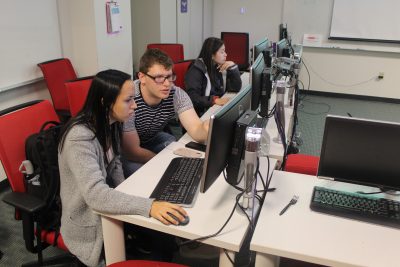 On Friday, April 26th, OPIM Innovate hosted its 3D Printing Workshop. There, lab specialist Eli Udler walked students through the 3D printing process with Tinkercad, an open-source computer-aided design platform. After a brief walkthrough on how to use the online tool, students were then given free rein to pursue and build any of the step-by-step projects provided by the Tinkercad support team. For those students who were beginners or still intimidated by the software, Udler recommended the pennywhistle tutorial. As students worked independently, Udler remained attentive and answered any and all questions as they were asked.
On Friday, April 26th, OPIM Innovate hosted its 3D Printing Workshop. There, lab specialist Eli Udler walked students through the 3D printing process with Tinkercad, an open-source computer-aided design platform. After a brief walkthrough on how to use the online tool, students were then given free rein to pursue and build any of the step-by-step projects provided by the Tinkercad support team. For those students who were beginners or still intimidated by the software, Udler recommended the pennywhistle tutorial. As students worked independently, Udler remained attentive and answered any and all questions as they were asked.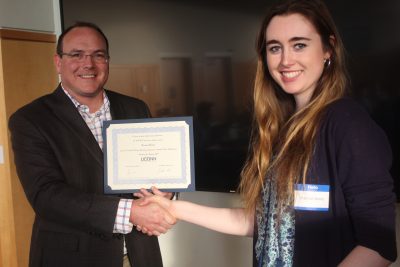 On Tuesday, April 23rd, the Operations and Information Management (OPIM) Department held its 2019 Management Information Systems (MIS) Scholarship Banquet. There, 45 MIS students were awarded on merit and academic excellence, with a new award, the “MIS MVP Award,” being handed out for the first time.
On Tuesday, April 23rd, the Operations and Information Management (OPIM) Department held its 2019 Management Information Systems (MIS) Scholarship Banquet. There, 45 MIS students were awarded on merit and academic excellence, with a new award, the “MIS MVP Award,” being handed out for the first time.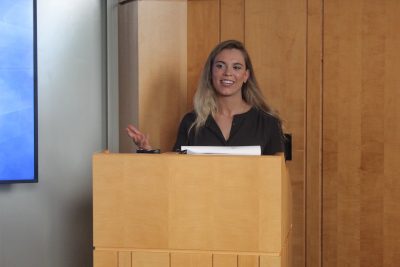 Recipients of the MIS scholarships had a minimum cumulative GPA of 3.60 and an average cumulative GPA of 3.72. This bested numbers from the previous year, where the minimum cumulative GPA was 3.57 and the average cumulative GPA was 3.69. After each student came up to receive their award, Moore then announced the winner of the MIS MVP Award:
Recipients of the MIS scholarships had a minimum cumulative GPA of 3.60 and an average cumulative GPA of 3.72. This bested numbers from the previous year, where the minimum cumulative GPA was 3.57 and the average cumulative GPA was 3.69. After each student came up to receive their award, Moore then announced the winner of the MIS MVP Award: 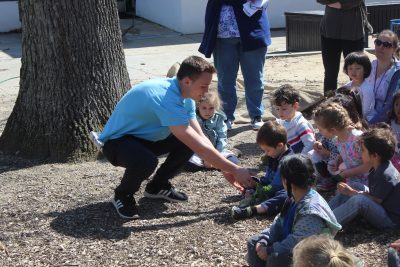 On Wednesday, April 28th, Levo International, in collaboration with OPIM Innovate, showcased one of its many hydroponic installations to preschoolers at the
On Wednesday, April 28th, Levo International, in collaboration with OPIM Innovate, showcased one of its many hydroponic installations to preschoolers at the  So, how does it work? Well, the hydroponic greenhouse is fueled by a nutrient reservoir filled mostly with nitrogen, potassium, and phosphorus. From there, the water is pumped up to the top of the greenhouse, where it then flows through all the pipes to the seated plants. After the water reaches each plant, it returns to the reservoir and is recycled on a solar-powered timer. All a user has to do is check the roots of the plants to prevent the system from clogging and replace the fertilizer every two-to-three weeks. “That was our goal: eliminate most of the hassle,” said Heiden in his explanation of the system. “Especially in the United States, people are always on a time crunch.”
So, how does it work? Well, the hydroponic greenhouse is fueled by a nutrient reservoir filled mostly with nitrogen, potassium, and phosphorus. From there, the water is pumped up to the top of the greenhouse, where it then flows through all the pipes to the seated plants. After the water reaches each plant, it returns to the reservoir and is recycled on a solar-powered timer. All a user has to do is check the roots of the plants to prevent the system from clogging and replace the fertilizer every two-to-three weeks. “That was our goal: eliminate most of the hassle,” said Heiden in his explanation of the system. “Especially in the United States, people are always on a time crunch.”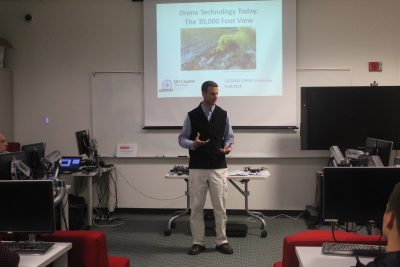 On Friday, April 19th, OPIM Innovate invited
On Friday, April 19th, OPIM Innovate invited 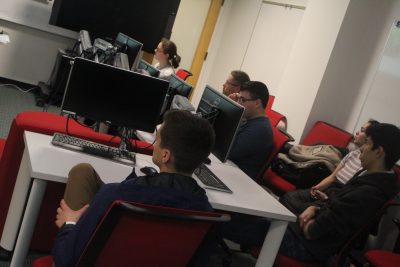 “My intention was to start an IT training company,” said Otrin while reminiscing about his business prototyping days. “But, deep down, it wasn’t really what I wanted. One of my mentors helped me realize that. After working on a 45-page business plan for 4 months, she said to me, ‘You know what, I can tell that this isn’t what lights you up.'” She asked Otrin to think about his childhood interests, his hobbies, what he reads, and his pastimes to steer him in the right direction in terms of creating a business he would enjoy running. It didn’t take long for him to pinpoint that he wanted to do something with aviation. “I went to airshows, read aviation magazines, was obsessed with flying–so I came back a week later and told her that I needed to do something aviation related.” Based on how quickly he wrote his second business plan, he realized that following his passions would lead to his success.
“My intention was to start an IT training company,” said Otrin while reminiscing about his business prototyping days. “But, deep down, it wasn’t really what I wanted. One of my mentors helped me realize that. After working on a 45-page business plan for 4 months, she said to me, ‘You know what, I can tell that this isn’t what lights you up.'” She asked Otrin to think about his childhood interests, his hobbies, what he reads, and his pastimes to steer him in the right direction in terms of creating a business he would enjoy running. It didn’t take long for him to pinpoint that he wanted to do something with aviation. “I went to airshows, read aviation magazines, was obsessed with flying–so I came back a week later and told her that I needed to do something aviation related.” Based on how quickly he wrote his second business plan, he realized that following his passions would lead to his success.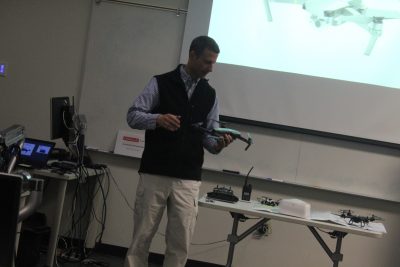 Outside of recreational use, drones have many practical applications that can be beneficial to various industries. They allow human beings to get to places they may not otherwise be able to go, see things from an overhead perspective, and make informed decisions. For instance:
Outside of recreational use, drones have many practical applications that can be beneficial to various industries. They allow human beings to get to places they may not otherwise be able to go, see things from an overhead perspective, and make informed decisions. For instance: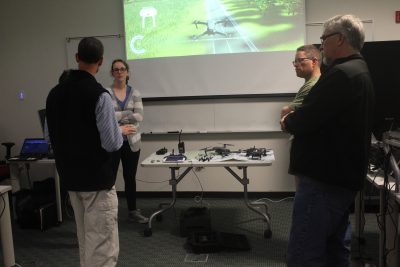 After the workshop, students left with a better understanding of drones and how they can utilize drone technology in their own pursuits. “I’ve had this idea for a while now to use drones as a way to help commuters find available parking spaces,” said computer science major
After the workshop, students left with a better understanding of drones and how they can utilize drone technology in their own pursuits. “I’ve had this idea for a while now to use drones as a way to help commuters find available parking spaces,” said computer science major 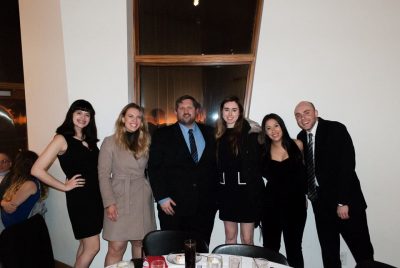 On Wednesday, April 10th, the University of Connecticut’s Operations and Information Management (OPIM) Department sent a team of talented students to participate in the University of Minnesota’s (UMN’s) CoMIS case competition. In order to qualify for the trip, each student had to take the Business Case Competitions independent study (OPIM
On Wednesday, April 10th, the University of Connecticut’s Operations and Information Management (OPIM) Department sent a team of talented students to participate in the University of Minnesota’s (UMN’s) CoMIS case competition. In order to qualify for the trip, each student had to take the Business Case Competitions independent study (OPIM 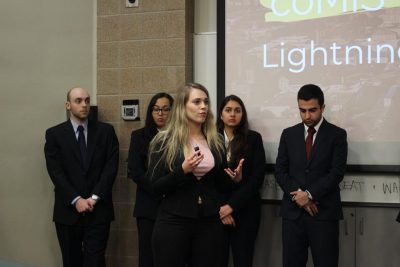 On day two, students and faculty were invited to partake in one of two tours: a tour of the Federal Reserve Bank of Minnesota or a tour of the U.S. Bank Stadium. Both were interesting snapshots of what Minneapolis had to offer and allowed competing schools to mingle with each other while experiencing something new. “The U.S. Bank Stadium definitely lived up to the hype,” said Gauthier. “Every aspect of the modern fan experience was covered and integrated with top class engineering and [information technology] solutions.” For the Federal Reserve Bank tour, both Moore and Kridzelis enjoyed learning about the Federal Reserve System and how artificial intelligence (A.I.) is helping workers count, transport, and sort money.
On day two, students and faculty were invited to partake in one of two tours: a tour of the Federal Reserve Bank of Minnesota or a tour of the U.S. Bank Stadium. Both were interesting snapshots of what Minneapolis had to offer and allowed competing schools to mingle with each other while experiencing something new. “The U.S. Bank Stadium definitely lived up to the hype,” said Gauthier. “Every aspect of the modern fan experience was covered and integrated with top class engineering and [information technology] solutions.” For the Federal Reserve Bank tour, both Moore and Kridzelis enjoyed learning about the Federal Reserve System and how artificial intelligence (A.I.) is helping workers count, transport, and sort money. When CoMMIT finally presented in front of their panel of judges, the professionalism that emanated from each team member masked any unease they were experiencing during the fifteen minutes they were given. Due to the creativity of CoMMIT’s solutions, they were able to get second place out of all teams in their randomized bracket for the preliminary round (which included three winning schools from the year before). This meant that they had a chance to go to finals through a question-and-answer lightning round. Unfortunately, they did not advance beyond this point, but ended up achieving seventh place overall “Our team stayed for a short time, but managed a good showing against steep competition,” said Moore. “Although there were times where I felt I would nearly fall down, I always had a teammate ready to pick me back up,” followed Trautman.
When CoMMIT finally presented in front of their panel of judges, the professionalism that emanated from each team member masked any unease they were experiencing during the fifteen minutes they were given. Due to the creativity of CoMMIT’s solutions, they were able to get second place out of all teams in their randomized bracket for the preliminary round (which included three winning schools from the year before). This meant that they had a chance to go to finals through a question-and-answer lightning round. Unfortunately, they did not advance beyond this point, but ended up achieving seventh place overall “Our team stayed for a short time, but managed a good showing against steep competition,” said Moore. “Although there were times where I felt I would nearly fall down, I always had a teammate ready to pick me back up,” followed Trautman.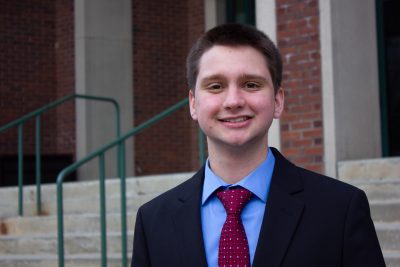 Raised in Wallingford, Connecticut, sophomore management information systems (MIS) major
Raised in Wallingford, Connecticut, sophomore management information systems (MIS) major  On Friday, March 29th, OPIM Innovate hosted its Alexa Skill-Building Workshop from 1:00 PM to 3:00 PM in the Gladstein Lab, BUSN 309. Led by
On Friday, March 29th, OPIM Innovate hosted its Alexa Skill-Building Workshop from 1:00 PM to 3:00 PM in the Gladstein Lab, BUSN 309. Led by  In addition to the A.I. exposition of the workshop, Lauretti also clarified a few common, yet incorrect assumptions about the Amazon Alexa. For one, the Alexa cannot be purchased from Amazon, unlike their Echo and Dot smart speakers. Why? Unlike Amazon’s physical hardware, the Alexa is a cloud-based voice service that connects to all Amazon smart devices and some third-party devices. As such, while Alexa is a complement to Amazon’s smart speakers, she is also the overarching artificial intelligence framework that keeps every device responsive. When Alexa is asked something through a smart speaker, for example, a recording of the request is sent to the Amazon cloud for processing and analysis. Then, once the meaning of the message is predicted, Alexa gives you her best response.
In addition to the A.I. exposition of the workshop, Lauretti also clarified a few common, yet incorrect assumptions about the Amazon Alexa. For one, the Alexa cannot be purchased from Amazon, unlike their Echo and Dot smart speakers. Why? Unlike Amazon’s physical hardware, the Alexa is a cloud-based voice service that connects to all Amazon smart devices and some third-party devices. As such, while Alexa is a complement to Amazon’s smart speakers, she is also the overarching artificial intelligence framework that keeps every device responsive. When Alexa is asked something through a smart speaker, for example, a recording of the request is sent to the Amazon cloud for processing and analysis. Then, once the meaning of the message is predicted, Alexa gives you her best response. Before utilizing Voiceflow, Lauretti had attendees create paper fortune tellers (shown to the right). The point of the exercise was to show how Alexa can only process voice information, and cannot utilize any other “senses” in order to make a decision. As such, while paper fortune tellers require you to pull, fold, unfold, and process visual information, Alexa cannot do that with her limitations; she can only be programmed to listen and respond. Thus, when attendees began to use Voiceflow, which allows you to chain commands and responses together in a circular decision-tree-like diagram, all of the different blocks available for use on the graphical interface involved either speaking or listening for information. For example, in emulating a paper fortune teller game, a “Speak” block can be created with directions on which color to pick so Alexa can voice them to the user. Then, that “Speak” block can be chained to a “Choice” block outlining all of the different choices to search for in the voice input (blue, red, yellow, or green, for example). If the user does not pick a color on that list, the “Choice” block can be linked back to the “Speak” block through an “else” option so Alexa can clarify the different color choices, again. As can be inferred, an Alexa skill diagram utilizing Voiceflow can become very involved very quickly. However, even if the visual model can become fairly complex, it is very simple to build.
Before utilizing Voiceflow, Lauretti had attendees create paper fortune tellers (shown to the right). The point of the exercise was to show how Alexa can only process voice information, and cannot utilize any other “senses” in order to make a decision. As such, while paper fortune tellers require you to pull, fold, unfold, and process visual information, Alexa cannot do that with her limitations; she can only be programmed to listen and respond. Thus, when attendees began to use Voiceflow, which allows you to chain commands and responses together in a circular decision-tree-like diagram, all of the different blocks available for use on the graphical interface involved either speaking or listening for information. For example, in emulating a paper fortune teller game, a “Speak” block can be created with directions on which color to pick so Alexa can voice them to the user. Then, that “Speak” block can be chained to a “Choice” block outlining all of the different choices to search for in the voice input (blue, red, yellow, or green, for example). If the user does not pick a color on that list, the “Choice” block can be linked back to the “Speak” block through an “else” option so Alexa can clarify the different color choices, again. As can be inferred, an Alexa skill diagram utilizing Voiceflow can become very involved very quickly. However, even if the visual model can become fairly complex, it is very simple to build. After the Alexa Skill-Building Workshop, many students left with a greater understanding of the Alexa service and Alexa skills. “I didn’t realize how simple it was to make skills for your Alexa,” said
After the Alexa Skill-Building Workshop, many students left with a greater understanding of the Alexa service and Alexa skills. “I didn’t realize how simple it was to make skills for your Alexa,” said